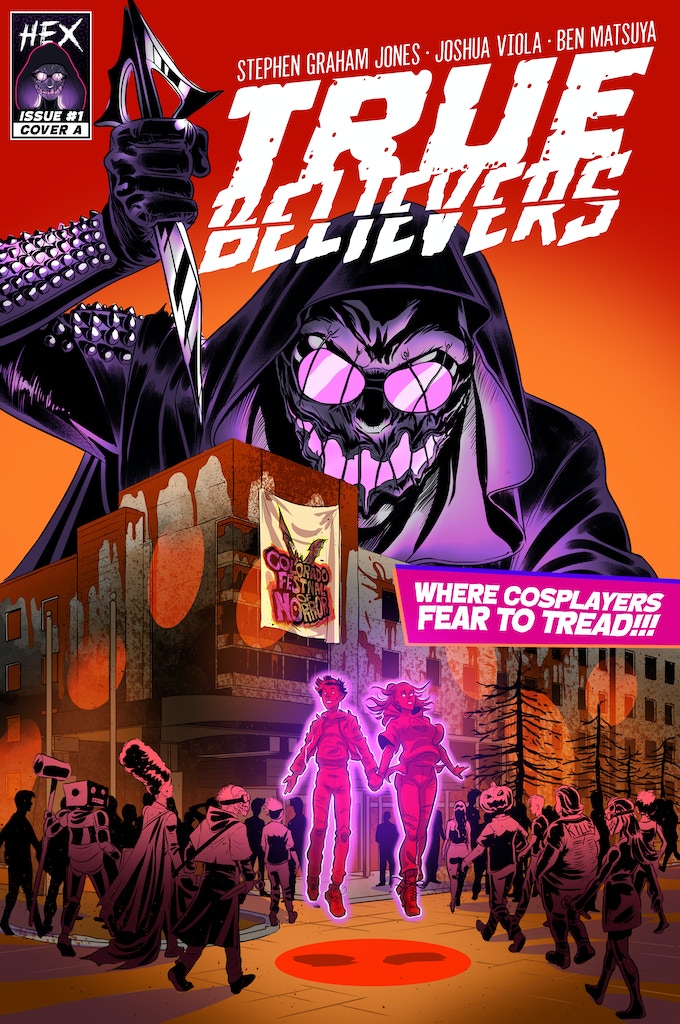
For many writers and artists, spending time at conventions is a regular part of an annual routine. It’s not surprising, then, that some have opted to use genre and comic book conventions as the setting for stories, including one of Evan Dorkin’s Eltingville Club stories, Nick Mamatas’s novel I Am Providence, and Paul Cornell and Marika Cresta’s Con & On.
Now, in the new series True Believers, writers Joshua Viola and Stephen Graham Jones teamed with artist Ben Matsuya for a tale of cosplay and horror set at the Colorado Festival of Horror. I talked with Viola about the process of bringing this book to life, the collaborative methods for writing the project, and the lines between reality and fantasy that run throughout the series.
When setting a book like this at a horror convention, to what extent are you drawing on your own experiences and to what extent are you heightening the absurd, surreal, or ominous elements of such an event?
True Believers exudes a sense of playfulness that touches on absurdity. Conventions are the ultimate breeding grounds for these kind of situations, and it’s precisely what they’re designed for –- a space where fans wholeheartedly embrace the outrageousness. It’s all part of the fun. However, when dealing with fiction, particularly when it’s intended as a sort of commentary, it’s essential to crank up the absurdity meter a notch or two. Going too close to reality can make for an uncomfortable experience, so the meta-narrative thrives on surrealism to maintain its entertainment value, I think. In the end, it’s these elements that truly make it an enjoyable read.
How did the collaborative writing process for the series work?
Stephen and I tossed ideas back and forth until we arrived at a concept that resonated with both of us. Stephen wrote draft one for the first portion of the story (at an airport). I edited that section and after we were happy with it, I wrote the second half, which Stephen later edited. Readers will notice a deliberate shift in the storytelling style, which was intentional to enhance the experience.
This is a book where, at least early on, there’s a great deal of ambiguity about what is and is not happening. From your perspective, what was the biggest challenge of that aspect of the comic?
That was our intention from the outset, and it turned out to be a good decision, I think. Stephen introduced a surprising twist into the narrative, one that even I didn’t anticipate, as it deviated from our initial idea. This added a layer of excitement to the creative process, and I think readers will also be caught off guard. Maintaining a sense of ambiguity throughout the story has sort of been our strategy. The challenge lies in executing these surprises seamlessly. Hopefully, we’ve succeeded in pulling it off.
What was the process like for coming up with a distinctive look for the story’s antagonist, Killr™?
The process of crafting Killr™’s look was a collaborative effort that involved several people. To begin with, Stephen and I needed to define the character. I proposed various ideas, and together, we selected one to explore further. Then we enlisted the talents of Xander Smith (known for his work on Scream Queens) to generate a range of concept art based on our chosen antagonist. Once we settled on a basic design, I enlisted my husband, Aaron Lovett (Miskatonic), to refine the details further. Finally, our interior artist, Ben Matsuya, took that iteration and transformed it into the definitive version of Killr™ in the comic.
In calling the book “True Believers,” it sounds like you’re edging into a broader critique of elements of comics fandom. Was there one impetus on hand to set this book in or adjacent to that community?
The central theme we always aimed to explore revolves around the notion of fandom taken to extremes. This concept was the foundation. Our narrative serves as a commentary on both the positive and negative aspects of being a devoted fan or “true believer.” We wanted to delve into the consequences of fandom turning toxic, probing into the territory of what transpires when someone believes they are the ultimate enthusiast, and fellow fans become perceived as adversaries. It’s a serious exploration, but we peppered it with plenty of lightheartedness and fun, I think. Ben’s artwork certainly helps lighten the mood.
I’ve read a lot of interesting writing on cosplay in recent years. Was there anything that you found interesting as a point of reference while working on the book?
Stephen and I are pretty familiar with cosplay culture, although we wouldn’t label ourselves as cosplayers. I’ve dabbled in it on occasion, but I’m no expert. However, being regular convention attendees, cosplay naturally becomes a part of the overall experience. I believe cosplay and the horror and slasher genres are a perfect fit. It’s like having a perpetual Halloween celebration, which is a delight for any horror enthusiast. And when it comes to slashers, the masks are a natural complement to the cosplay scene. It’s like they were made for each other. It creates a trifecta of experiences ripe for storytelling opportunities. In terms of our creative process though, we didn’t draw specific references beyond our own convention experiences. However, it’s important to note that our commentary on toxic fandom primarily revolves around online fan communities. Our convention experiences have always been incredibly friendly and enjoyable.
Follow Vol. 1 Brooklyn on Twitter, Facebook, and sign up for our mailing list.
